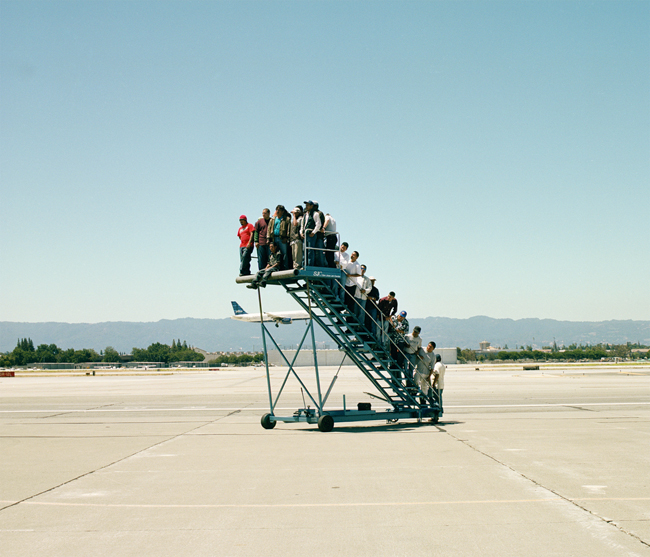
IMAGINED PLACES
ADRIAN PACI, ZINEB SEDIRA, BOUCHRA KHALILI, CLAUDIA CRISTOVÃO, HO-YEOL RYU
13 DECEMBER 2012 TO 14 APRIL 2013
Does a person’s location determine their identity?
Centro di Permanenza Temporanea, Adrian Paci, 2009, framed photograph, cm 120x 140 print,courtesy of the artist and Kaufman Repetto gallery Milan | ||
Does a person’s location determine their identity? Imagined Places is not about the significance of physical place, it is about our sense of connection to places elsewhere. Adrian Paci, Zineb Sedira, Bouchra Khalili, Claudia Cristovão and Ho-Yeol Ryu present photos and video installations depicting real and imaginary places, chosen and unchosen journeys Imagined Places is an exhibition about the desire to be elsewhere and the reality of forced migration.
Impressive video installations show connections to places MiddleSea (2008), by Zineb Sedira (b. 1963, Paris) is a monumental, immersive video installation about how people can find themselves between different places. MiddleSea shows a man wandering about the empty corridors of a ship at sea. It is unclear where he comes from or where he is going or even whether this is about a real voyage, a dream image or a memory. Mikhail Karikis’s soundtrack emphasizes this ambiguity. MiddleSea provides a poetic, universal image of the journeys that generations of migrants have made, both physically, and in memory. Fata Morgana (2006), a video installation by Claudia Cristovão (b. 1973, Luanda) features five Portuguese people born in Angola, describing the country they came from. Their stories sketch an imaginary Africa which exists only in inherited memories and projected ideals. Although the place they describe with such passion does not actually exist, it is clear that it forms a genuine part of their identity. The stories are flanked by pictures of a shimmering plain and a deserted city: the landscapes onto which memories and desires are projected. The Mapping Journey (2009), by Bouchra Khalili (b. 1975, Casablanca), illustrates the reality of migration. In this video installation, eight people describe the routes they have travelled on a world map. Their journeys demonstrate how lives today cannot be defined by cartographic contours. By taking their experiences as a starting point, and not as exceptions, Khalili challenges viewers to look at maps in a different way, reflecting the reality of migration and mobility. Personal and shared themes in video Together, these five works provide an image of a collective experience of a time in which migration and mobility play a central role. Video and photography are powerful mediums for this experience, and enable artists to manipulate reality and fiction and so switch between external reality and internal experience. In Imagined Places, the unique possibilities of video and photography enable the artists to show how people connect to places, especially through memory and fantasy, rather than physical interaction. Concepts such as culture and identity The exhibition takes a critical look at the way many define culture and identity by geographical location. How relevant and productive is it in an increasingly globalized world to continue to treat African, Moroccan or Dutch culture and identity as separate and confined? Are there other ways of understanding and representing people’s experience of culture and identity? In Imagined Places, five artists offer powerful alternative options. | ||
|
TROPENMUSEUM
Tropenmuseum
Linnaeusstraat 2 1092 CK AMSTERDAM The Netherlands INFORMATION: • Phone: +31 20 568 8200 • Website: http://www.tropenmuseum.com/-/MUS/79972/Tropenmuseum/Exhibitions-Events/Exhibitions-Events-Imagined-Places • Mail : info@tropenmuseum.nl OPENING TIMES: Tuesdays to Sundays: 10 AM – 5 PM ADMISSION PRICE: 13 and older: € 12 4 to 12 years-old: € 8
|
||

